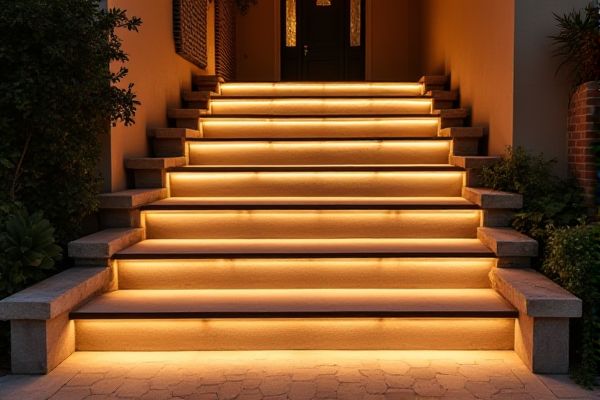
Illuminated treads provide direct lighting on the stair surface for enhanced visibility, while edge-lit treads use LED strips along the edges to create a subtle glow that highlights stair contours. Discover the key differences and benefits to choose the best option for your staircase in the rest of this article.
Table of Comparison
| Feature | Illuminated Treads | Edge-Lit Treads |
|---|---|---|
| Lighting Source | Integrated LEDs within each tread | LEDs embedded along tread edges |
| Light Distribution | Uniform, direct illumination across the tread surface | Subtle glow emphasizing the edges |
| Energy Efficiency | Higher energy usage due to full surface lighting | More efficient with minimal power consumption |
| Aesthetic Appeal | Bold, modern-visible lighting effect | Elegant, minimalist edge glow |
| Installation Complexity | Moderate; requires wiring within each tread | Simple; wiring mostly confined to edges |
| Cost | Generally higher due to integrated lighting elements | Typically lower, cost-effective edge lighting |
| Durability | Durable, protected LEDs within tread | LEDs exposed along edges, potential vulnerability |
| Best Use Case | High visibility stairs needing full surface illumination | Accent lighting for aesthetic enhancement |
Introduction to Illuminated and Edge-Lit Stair Treads
Illuminated stair treads utilize embedded LED lights within each step, providing direct, vibrant illumination that enhances safety and aesthetic appeal. Edge-lit stair treads feature lights along the outer edges, emitting a subtle, continuous glow that defines each step while maintaining a sleek, modern look. Both options improve visibility in low-light environments, but illuminated treads offer more concentrated lighting, whereas edge-lit designs emphasize minimalistic elegance.
Understanding Illuminated Treads: Function & Benefits
Illuminated treads use integrated LED lights embedded within the stair surface, enhancing safety by clearly defining each step in low-light conditions. This technology improves visibility and reduces the risk of tripping, especially in residential and commercial staircases. The energy-efficient LEDs also offer long-lasting illumination with minimal maintenance, making illuminated treads a practical and stylish choice for modern stair design.
What Are Edge-Lit Treads? Key Features Explained
Edge-lit treads use LED lights embedded along the edges, creating a sleek, continuous glow ideal for modern staircases. These treads enhance safety by providing clear visibility in low-light conditions without distracting brightness. Your space benefits from a minimalist design with energy-efficient illumination, emphasizing both aesthetics and functionality.
Safety Advantages: Illuminated vs Edge-Lit Stair Treads
Illuminated treads provide consistent, high-visibility lighting across the entire stair surface, significantly reducing trip hazards and enhancing overall safety. Edge-lit treads focus illumination along the edges, which can create shadows or dim areas in the center, potentially increasing the risk of missteps. Enhanced visibility from illuminated treads supports better depth perception, making them a superior choice for preventing accidents in low-light environments.
Aesthetic Appeal: Design Differences and Visual Impact
Illuminated treads incorporate lighting within the steps themselves, creating a bold, uniform glow that enhances safety and adds a modern, high-tech aesthetic to staircases. Edge-lit treads feature lighting along the edges, producing a subtle, elegant outline that emphasizes the stair shape and delivers a sleek, minimalist visual impact. The choice between illuminated and edge-lit treads significantly influences the design mood, where illuminated treads highlight each step distinctly, while edge-lit treads create continuous, ambient lighting for a refined atmosphere.
Installation Process: Illuminated Treads vs Edge-Lit Options
Illuminated treads typically require wiring beneath each step, involving more complex installation that demands precise alignment and electrical connections to ensure consistent lighting. Edge-lit treads feature LED strips embedded along the edges, offering a simpler installation process with fewer wiring points and easier integration into existing staircases. Your choice depends on the level of customization and installation complexity you're prepared to manage for optimal stair lighting.
Energy Efficiency and Maintenance Comparison
Illuminated treads typically use individual LED lights embedded within each step, offering targeted brightness with lower overall energy consumption compared to edge-lit treads, which rely on light diffusing along the edges and often require higher wattage. Maintenance for illuminated treads tends to be simpler due to modular LED units that can be replaced individually, whereas edge-lit treads may need more complex servicing to address uniform lighting issues along the entire edge. Energy efficiency is enhanced in illuminated treads through precise light placement, reducing power waste, while edge-lit systems may incur higher costs over time due to diffused light loss and more frequent maintenance.
Customization and Material Choices
Illuminated treads offer extensive customization options, including a variety of LED colors, brightness levels, and patterns, allowing for tailored aesthetic effects to suit different design themes. These treads typically use durable materials such as tempered glass or acrylic to enhance light diffusion and withstand heavy foot traffic. Edge-lit treads mainly utilize acrylic or polycarbonate with LED strips embedded along the edges, providing a sleek, uniform glow but with fewer options for light color changes or complex designs.
Cost Analysis: Upfront Investment and Long-Term Value
Illuminated treads generally require a higher upfront investment due to integrated lighting components and more complex installation processes compared to edge-lit treads, which utilize simpler LED strips along the stair edges. Over time, edge-lit treads offer cost efficiency through lower energy consumption and easier maintenance, while illuminated treads may incur increased costs from potential replacements and repairs. Evaluating both options depends on balancing initial spending against durability, energy use, and the desired aesthetic impact on stairway safety and ambiance.
Choosing the Right Solution for Your Staircase
Illuminated treads offer uniform light distribution by embedding LEDs directly within each step, enhancing safety and aesthetic appeal in modern staircases. Edge-lit treads use LED strips along the step edges, creating a subtle glow that highlights the stair profile while conserving energy. Selecting between illuminated and edge-lit treads depends on desired brightness, installation complexity, and design preferences, with illuminated treads providing higher visibility and edge-lit options offering minimalist elegance.
 homyna.com
homyna.com